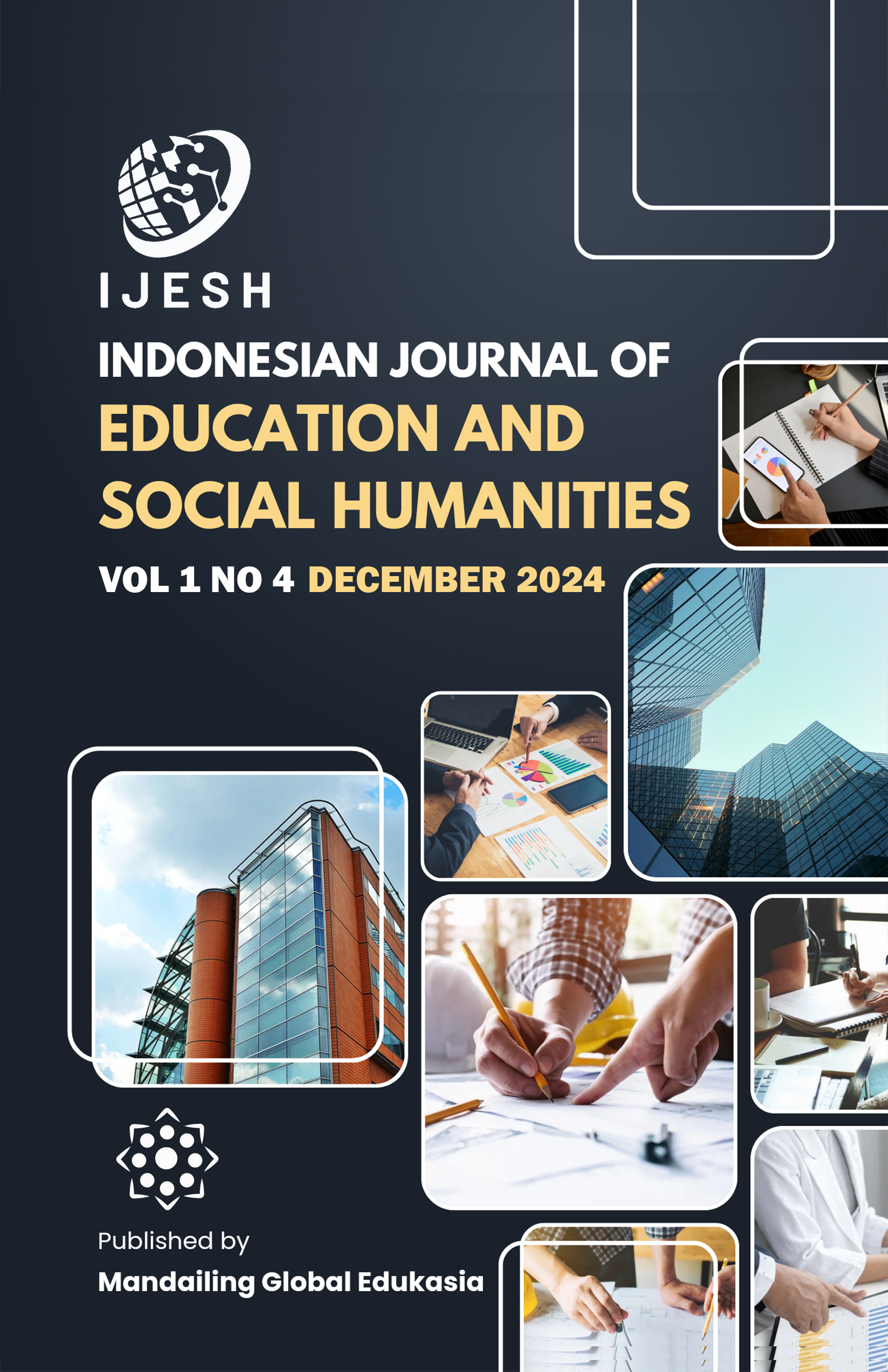The Influence of Collaborative Learning Model on Students' Communication Ability in Natural Science Lessons at MI Al Hikmah
DOI:
https://doi.org/10.62945/ijesh.v1i4.707Keywords:
IPA communication ability, collaborative learning model, learning outcomesAbstract
The collaborative learning model aims to maximize the process of cooperation that takes place naturally between students and appreciate the importance of the social context for the learning process. Based on that, the author defines the problem formulation as follows: (1) How is the implementation of the collaborative learning model for class V students in the IPA MI Al Hikmah Masangan Bungah Gresik curriculum? (2) How is the communication ability of class V students in the IPA MI Al Hikmah Lessons Bungah Gresik? (3) How does the implementation of the collaborative learning model influence the communication skills of class V students in the IPA Lessons Al Hikmah Bungah Gresik? As for this research, it was conducted to find out whether or not there is an influence of the collaborative learning model on IPA communication skills. In this research using a quantitative approach with a quasi-experimental type of research. The population of this research is the entire V MI Al Hikmah Masangan class. The sample is determined through the Total Sampling technique. Based on the technique, VA class was obtained as an experimental class while VB class was a control class. The data collection technique uses an essay test. Data were analyzed using hypothesis testing (t test). The results of the research show that the IPA communication ability of students taught with the Collaborative Learning Model is higher than the IPA communication ability of students taught with the conventional learning model. The IPA communication ability in the experimental class (VA) with the Collaborative Learning Model obtained a posttest average of 76.9, while in the control class (VB) with the conventional learning model, the posttest average was 63.25. Based on the results of the hypothesis testing obtained thitung > ttabel ie 7.41 > 2.024 at the level of significance ???? = 0.05. This means that the hypothesis in this research can be accepted and it is stated that there is a positive and significant influence from the use of the Collaborative Learning Model on the communication skills of V class MI Al Hikmah Masangan students in IPA subjects.
Downloads
References
Arikunto, S. (2002). Prosedur Penelitian. Bandung: Rineka Cipta.
Apriyanti, I., & Rahayu, S. (2024). Efforts to Improve Student Learning Outcomes through the Problem Based Learning Model in Islamic Education Learning at SD Negeri 104325 Kampung Manggis. Journal of Indonesian Primary School, 1(2), 61–68.
Elistiana, V., Novita, N., & Ginting, F. W. (2024). A Development of E-Module Learning Media based on SETS (Science, Environment, Technology, and Society) on Sound Wave Material. Indonesian Journal of Education and Social Humanities, 1(2), 20–32.
Erawadi, E., Hamka, H., & Juliana, F. (2017). The Analysis of Student’s Stressed Syllables Mastery at Sixth Semester of TBI in IAIN Padangsidimpuan. English Education: English Journal for Teaching and Learning, 5(1), 44–57.
Hamka, H. (2023). The Role of Principals on Teacher Performance Improvement in a Suburban School. QALAMUNA: Jurnal Pendidikan, Sosial, Dan Agama, 15(1), 371–380.
Hamka, H., Suen, M.-W., Anganthi, N. R. N., Haq, A. H. B., & Prasetyo, B. (2023). The Effectiveness of Gratitude Intervention in Reducing Negative Emotions in Sexual Abuse Victims. Psikohumaniora: Jurnal Penelitian Psikologi, 8(2), 227–240.
Harahap, D. S. (2024). Implementation of ChatGPT to Improve Students’ Critical Thinking Abilities. Indonesian Journal of Education and Social Humanities, 1(2), 33–39.
Harahap, S. M., & Hamka, H. (2023). Investigating the Roles of Philosophy, Culture, Language and Islam in Angkola’s Local Wisdom of ‘Dalihan Na Tolu.’ HTS Teologiese Studies/Theological Studies, 79(1), 8164.
Indrawati, N., & Desky, A. Y. D. (2024). How to Improve Elementary School Student Learning Outcomes by Implementing the Articulation Type Cooperative Learning Model? Journal of Indonesian Primary School, 1(2), 32–37.
Jannah, A., Lubis, A. H., & Julia, N. M. (2024). Development of Number Card Media in Mathematics Learning for Elementary School Students. Journal of Indonesian Primary School, 1(3), 12–23.
Latifah, I., & Safrida, I. (2025). Improving Students’ Language Skills with Punakawan Wayang Media at RA Mansyaul Huda: A Classroom Action Research. Journal of Indonesian Primary School, 2(1), 13–24.
Lubis, A. H. (2024). Improving Elementary School Students’ Reading Skills Using Picture Word Cards: How is This Possible? Journal of Indonesian Primary School, 1(2), 9–18.
Lubis, A. H., & Lubis, S. S. W. (2024). Development of Newsletter Media in Thematic Learning for Elementary School Students. Indonesian Journal of Education and Social Humanities, 1(1), 28–36.
Mauliana, I., Ulfa, N., & Fitria, A. (2024). Improving Student Learning Outcomes with the Problem Based Learning Model: Classroom Action Research at the State Islamic Primary School. Indonesian Journal of Education and Social Humanities, 1(2), 1–8.
Misqa, L., Oviana, W., Hayati, Z., & Jannah, M. (2024). Improving Student Learning Outcomes in Mathematics Learning through a Contextual Teaching and Learning Approach in Elementary Schools. Journal of Indonesian Primary School, 1(2), 19–26.
Muliawati, I., & Aldin, A. (2024). The Effectiveness of the Problem Based Learning Model on Elementary School Students’ Mathematics Learning Outcomes. Journal of Indonesian Primary School, 1(2), 27–31.
Nurliza, M., Lubis, A. H., & Lubis, S. S. W. (2024). Word Square Model Used by Poster Media to Improve Primary School Student Learning Outcomes. Journal of Indonesian Primary School, 1(1), 19–28.
Rahayu, L., & Daud, R. M. (2024). SAS Method assisted by Picture Story Books to Improve Elementary School Students’ Beginning Reading Ability. Journal of Indonesian Primary School, 1(1), 37–46.
Rahmah, S., & Lubis, A. H. (2024). Problem Posing as a Learning Model to Improve Primary School Students’ Mathematics Learning Outcomes in Gayo Lues. Journal of Indonesian Primary School, 1(4), 93–104.
Simamora, R. (2024). A Survey Research: What is the Role of the Mendeley Application in the Student Environment? Indonesian Journal of Education and Social Humanities, 1(2), 40–45.
Sugiyono. (2018). Metode Penelitian Kuantitatif Kualitatif dan R&D. Bandung: Alfabeta.
Downloads
Published
How to Cite
Issue
Section
License

This work is licensed under a Creative Commons Attribution-ShareAlike 4.0 International License.









